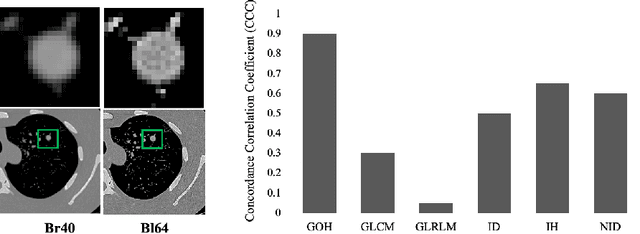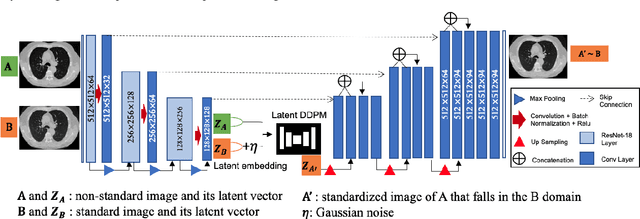Michael A. Brooks
Latent Diffusion Model for Medical Image Standardization and Enhancement
Oct 08, 2023



Abstract:Computed tomography (CT) serves as an effective tool for lung cancer screening, diagnosis, treatment, and prognosis, providing a rich source of features to quantify temporal and spatial tumor changes. Nonetheless, the diversity of CT scanners and customized acquisition protocols can introduce significant inconsistencies in texture features, even when assessing the same patient. This variability poses a fundamental challenge for subsequent research that relies on consistent image features. Existing CT image standardization models predominantly utilize GAN-based supervised or semi-supervised learning, but their performance remains limited. We present DiffusionCT, an innovative score-based DDPM model that operates in the latent space to transform disparate non-standard distributions into a standardized form. The architecture comprises a U-Net-based encoder-decoder, augmented by a DDPM model integrated at the bottleneck position. First, the encoder-decoder is trained independently, without embedding DDPM, to capture the latent representation of the input data. Second, the latent DDPM model is trained while keeping the encoder-decoder parameters fixed. Finally, the decoder uses the transformed latent representation to generate a standardized CT image, providing a more consistent basis for downstream analysis. Empirical tests on patient CT images indicate notable improvements in image standardization using DiffusionCT. Additionally, the model significantly reduces image noise in SPAD images, further validating the effectiveness of DiffusionCT for advanced imaging tasks.
DiffusionCT: Latent Diffusion Model for CT Image Standardization
Jan 20, 2023



Abstract:Computed tomography (CT) imaging is a widely used modality for early lung cancer diagnosis, treatment, and prognosis. Features extracted from CT images are now accepted to quantify spatial and temporal variations in tumor architecture and function. However, CT images are often acquired using scanners from different vendors with customized acquisition standards, resulting in significantly different texture features even for the same patient, posing a fundamental challenge to downstream studies. Existing CT image harmonization models rely on supervised or semi-supervised techniques, with limited performance. In this paper, we have proposed a diffusion-based CT image standardization model called DiffusionCT which works on latent space by mapping latent distribution into a standard distribution. DiffusionCT incorporates an Unet-based encoder-decoder and a diffusion model embedded in its bottleneck part. The Unet first trained without the diffusion model to learn the latent representation of the input data. The diffusion model is trained in the next training phase. All the trained models work together on image standardization. The encoded representation outputted from the Unet encoder passes through the diffusion model, and the diffusion model maps the distribution in to target standard image domain. Finally, the decode takes that transformed latent representation to synthesize a standardized image. The experimental results show that DiffusionCT significantly improves the performance of the standardization task.
 Add to Chrome
Add to Chrome Add to Firefox
Add to Firefox Add to Edge
Add to Edge